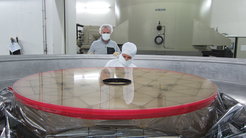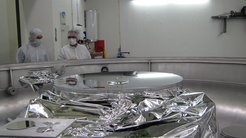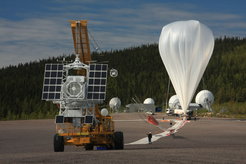New Shine for Sunrise’s Telescope
The balloon mission Sunrise is to take off again in two years. The telescope's main mirror has now been coated with a fresh layer of aluminum.
The balloon mission Sunrise, which aims a high-resolution telescope at the Sun from a flight altitude of more than 35 kilometers, is preparing for its next flight. The observatory is scheduled to embark on its third expedition in the summer of 2021. Preparatory work on the main mirror measuring one meter in diameter has already begun. At the Calar Alto Observatory in southern Spain, the mirror has now been coated with a new layer of aluminum. Scientists and engineers from the Max Planck Institute for Solar System Research (MPS) in Germany, which leads the mission, accompanied the work on site.
The Sunrise mission is an adventure: carried by a giant helium balloon, the unmanned observatory peers at the Sun from an altitude of more than 35 kilometers; several days of flight are followed by a parachute landing. Twice already, the delicate main mirror of Sunrise’s telescope has survived this daring expedition undamaged. "But such a flight does not leave the mirror completely unscathed," explains Sunrise project manager Dr. Andreas Lagg from MPS. The quality of the outer layer of reflective aluminum is impaired; it must be renewed before every additional flight.

Telescopes that look into space from the ground face a similar problem: wind and weather affect their thin aluminum layer. The Calar Alto Observatory in the Sierra de los Filabres in southern Spain, which is operated by the Andalusian Institute for Astrophysics (IAA), a partner of the Sunrise mission, is therefore equipped with its own facility for re-aluminizing mirrors. There, the Sunrise mirror has now been spruced up for its next mission.
"Everything worked out wonderfully," says MPS scientist Dr. Achim Gandorfer, who was on site together with other MPS colleagues. "The mirror is as good as new again".
However, it will be some time before the telescope can launch again. Sunrise's third flight is scheduled for June 2021. By then, the scientific instruments that use and analyze the sunlight provided by the telescope will also be ready for take-off. Sunrise III will be equipped with three instruments. They will measure the magnetic fields on the surface of the Sun, examine its ultraviolet (UV) radiation and its visible light up to the near infrared. "Our instruments provide us with information from different layers of the Sun," explains Sunrise Principal Investigator Prof. Dr. Sami K. Solanki, Director at MPS. "With Sunrise, the vertical layering of the solar atmosphere can be determined with unprecedented accuracy," he adds. In addition to the telescope itself, the MPS contributes the UV spectrograph SUSI, the light distribution unit ISLiD and the 320 Terabyte onboard data storage unit to the mission.

The flight altitude of the observatory, too, contributes to Sunrise’s unique view of the Sun. "The observation position in the stratosphere is superior to that of any terrestrial solar telescope – without calling for the immense costs of a space mission," explains Lagg. Having arrived in the stratosphere, Sunrise has left more than 95 percent of the atmosphere behind. This wafting layer of air absorbs most of the ultraviolet radiation from the Sun, which contains information about the star’s outer layers. It is therefore mostly not available to ground-based telescopes.
In addition, constant air movements in the atmosphere disturb the view from Earth's surface. Uninterrupted observations lasting several hours are almost impossible. "Sunrise, on the other hand, has the potential to track how individual structures on the Sun change and develop over a much longer period," says Solanki.

The Sunrise mission is led by the Max Planck Institute for Solar System Research (MPS) in Germany. The institute is also developing the observatory's telescope, the UV spectrograph SUSI, the light distribution unit and the on-board data storage unit. The National Astronomical Observatory of Japan (NAOJ, Japan), the Andalusian Institute for Astrophysics (IAA, Spain), the Leibniz Institute for Solar Physics (KIS, Germany) and the Applied Physics Laboratory of Johns Hopkins University in the USA are contributing further scientific instruments and decisive hardware components to the mission. Another partner is the Columbia Scientific Balloon Facility (CSBF) of the American space agency NASA. Sunrise has already embarked twice on its unique journey, in 2009 and 2013, and landed again successfully after several days of observations.


